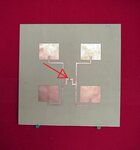GiedriusR
Newbie level 3
Hi, I am working on a 4x4 rectangular microstrip patch antenna array for my uni project and I can't find a proper way to feed the whole array. I have found that most of the people usually feed the whole array using a bottom insert feed, but whenever I try to do the same - CST simulation results show a very low S1,1 result. I have tested the design as well to check that simulation results are correct with no luck. Could anyone please recommend me a proper way of feeding a large microstrip array?

